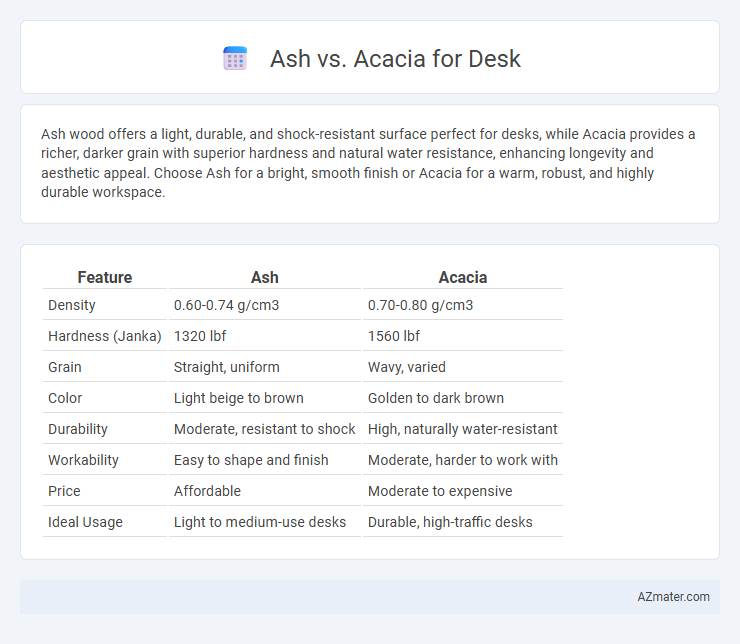Ash wood offers a light, durable, and shock-resistant surface perfect for desks, while Acacia provides a richer, darker grain with superior hardness and natural water resistance, enhancing longevity and aesthetic appeal. Choose Ash for a bright, smooth finish or Acacia for a warm, robust, and highly durable workspace.
Table of Comparison
| Feature | Ash | Acacia |
|---|---|---|
| Density | 0.60-0.74 g/cm3 | 0.70-0.80 g/cm3 |
| Hardness (Janka) | 1320 lbf | 1560 lbf |
| Grain | Straight, uniform | Wavy, varied |
| Color | Light beige to brown | Golden to dark brown |
| Durability | Moderate, resistant to shock | High, naturally water-resistant |
| Workability | Easy to shape and finish | Moderate, harder to work with |
| Price | Affordable | Moderate to expensive |
| Ideal Usage | Light to medium-use desks | Durable, high-traffic desks |
Introduction: Ash vs Acacia for Desk Selection
Ash and Acacia are popular hardwoods for desks, each offering unique qualities. Ash wood is valued for its light color, straight grain, and excellent durability, making it ideal for a classic, sturdy desk. Acacia features a rich, varied grain pattern and natural resistance to wear, providing a warm, exotic appearance that adds character to any workspace.
Origin and Sustainability of Ash and Acacia
Ash wood, primarily sourced from North America and Europe, is renowned for its strength and shock resistance, making it a durable choice for desks. Acacia, native to Australia and parts of Asia, offers exceptional sustainability due to its fast growth and natural resistance to pests without heavy chemical use. Both woods support eco-friendly furniture production, but Acacia's rapid renewability often makes it a more sustainable option in environmentally conscious designs.
Visual Appearance and Aesthetic Differences
Ash wood features a light, creamy color with prominent, straight grain patterns that create a clean, modern aesthetic ideal for contemporary desks. Acacia wood offers a richer, darker hue with varied grain textures and natural knots, delivering a warm, rustic, and distinctive look. The visual contrast between ash's bright, uniform appearance and acacia's deep, textured surface influences the overall ambiance and style of office spaces.
Durability and Hardness Comparison
Ash wood offers superior durability and hardness compared to acacia, making it more resistant to dents and scratches, which is critical for desk surfaces subjected to daily use. With a Janka hardness rating around 1320, ash provides a tough surface that withstands impact better than acacia's rating of approximately 1600, though the actual performance may vary depending on the acacia species. Ash also exhibits excellent shock resistance and flexibility, ensuring long-term structural integrity for desks, while acacia's natural oils enhance water resistance but may be softer under sustained pressure.
Grain Patterns and Texture Characteristics
Ash wood features prominent, straight grain patterns with a coarse texture, offering a light, airy appearance ideal for modern desks. Acacia wood exhibits varied, swirling grain patterns with a smoother, more tactile texture, providing a rich, warm aesthetic suited to rustic or traditional desks. The distinct grain and texture differences influence both the visual appeal and durability, making ash more uniform and acacia more expressive in desk designs.
Maintenance Requirements for Each Wood Type
Ash wood requires regular oiling or waxing to maintain its natural sheen and prevent drying or cracking, thriving in moderate humidity environments to avoid warping. Acacia is more durable and naturally resistant to moisture and pests, demanding less frequent upkeep but benefits from periodic cleaning with a damp cloth and occasional application of wood polish. Both woods should be kept away from direct sunlight and extreme temperature changes to preserve their structural integrity and appearance.
Cost and Availability in the Market
Ash wood is generally more affordable than Acacia, making it a popular choice for budget-conscious consumers seeking durable desks. Acacia, known for its rich color and unique grain patterns, tends to be pricier due to its hardwood density and slower growth rate. Ash is widely available in most furniture markets and lumber suppliers, whereas Acacia's availability can be limited and often imported, impacting its cost and accessibility.
Environmental Impact and Eco-Friendliness
Ash wood, sourced from fast-growing trees, generally has a lower environmental impact due to its rapid renewability and efficient carbon sequestration. Acacia wood, often harvested from slower-growing tropical species, may contribute to deforestation if not responsibly managed, impacting biodiversity and soil health. Choosing sustainably certified ash for desks supports eco-friendly practices by minimizing habitat disruption and enhancing resource conservation.
Suitability for Modern and Traditional Desk Designs
Ash wood offers a light, uniform grain that complements modern desk designs with clean lines and minimalist aesthetics, enhancing brightness and spaciousness. Acacia wood features rich, varied tones and distinct grain patterns ideal for traditional desks seeking a warm, rustic, and timeless appeal. Both woods provide durability, but ash suits sleek, contemporary workspaces while acacia favors classic, ornate environments.
Final Verdict: Choosing Between Ash or Acacia for Your Desk
Ash offers a light, consistent grain with strong durability, making it ideal for a modern, minimalistic desk design. Acacia features rich, varied tones and high density, providing excellent resistance to wear and a warm, rustic aesthetic. Choosing between ash and acacia depends on your preference for durability and appearance, with ash suited for sleek, contemporary spaces and acacia for a more robust, natural look.

Infographic: Ash vs Acacia for Desk
 azmater.com
azmater.com